Mealybugs on Plants: Effective Ways to Kill These White Bugs
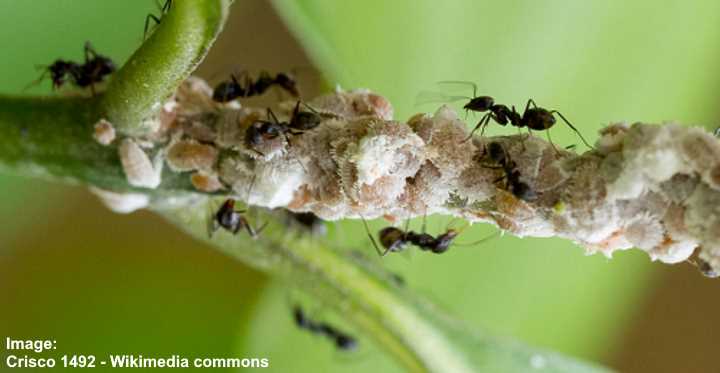
Mealybugs are sap-sucking scale insects that can do a lot of damage to your houseplants or outdoor plants. Mealybugs on plants look like small white bugs or they may appear as white fuzzy stuff on plant leaves and stems.
A mealybug infestation will cause leaves to lose color and wilt. If you don’t get rid of mealybugs, they can end up killing your plants. The classic sign of a mealybug infestation is tiny white bugs on plants.
Mealybugs are a type of insect belonging to the family Pseudococcidae. Mealybugs are related to other kinds of scale bugs. The little white bugs develop a powdery, waxy layer, which gives them a fuzzy look. Mealybugs are small crawling creatures measuring about 2 mm long.
You can identify a mealybug houseplant infestation by their cotton-like residue they leave on plant leaves and stems. Other signs of mealybug damage on plants include a sweet, sticky honeydew secreted by the plant-killing bugs. You may also notice black sooty mold fungus if you’ve got mealybugs on plants.
This article is a complete guide to getting rid of mealybugs on plants. You’ll find out about the life cycle of mealybugs and natural ways to rid your houseplants of these tiny critters.
What do Mealybugs Look Like?
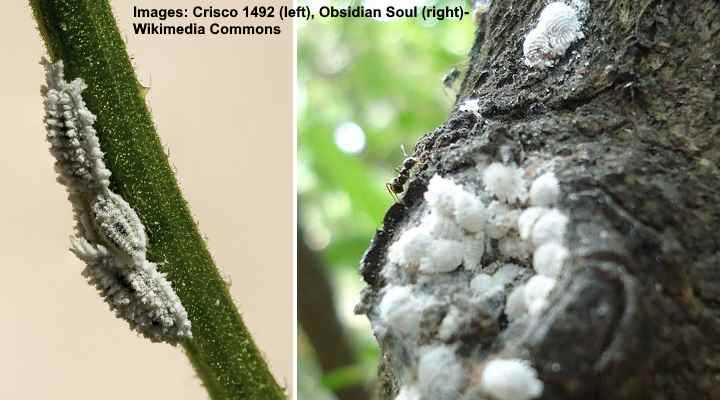
Mealybugs look like small oval white bugs. These scale insects can also look like white fuzzy bugs on plant leaves and stems.
Mealybugs look like fuzzy tiny white bugs crawling on plant leaves and stems. Before they reach maturity, mealybugs have a tan or cream color. It’s easy to mistake them for white plant fungus. But, looking up close, you’ll identify tiny white insects with a soft, oval body.
According to the University of California, mealybugs have a small, segmented body that’s covered with wax. This waxy appearance can become powdery, which gives the bugs a furry appearance. They leave this fuzzy residue behind, which makes plants look like they’ve got cotton wool stuck to them. (1)
Looking at close-up pictures of mealybugs, you’ll notice microscopic spines sticking out from their oval bodies. Some species of mealybugs have long filaments at their rear end, giving them an appearance of having long tails. Mealybugs also feed in colonies so that they can look like clumps of white fuzz.
Mealybugs Life Cycle
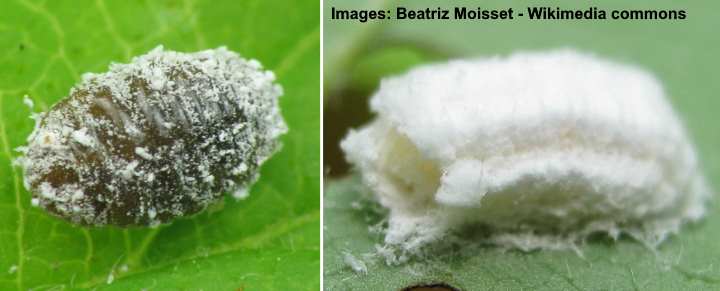
Adult mealybug (left) start its life cycle as a nymph emerging from white fuzzy egg sac (right)
The life cycle of mealybugs starts as an egg, turning to a nymph which molts several times before reaching adulthood. The full mealybug life cycle is between seven and ten weeks.
Female mealybugs can lay between 100 and 200 eggs in a 20-day period. The white cottony mealybug eggs stick to leaves, bark, or twigs. It takes between seven and fourteen days for nymphs to emerge from eggs. After hatching, nymphs molt several times before reaching adulthood.
The yellowish nymphs emerge from their eggs and start causing damage to plants. The tiny bugs crawl around the plant, leaving a waxy substance on them. As they grow, they bite into plant tissue to feed on sap. They also leave behind sticky honeydew that can attract other plant pests.
The challenge with identifying mealybugs on houseplants is that the eggs and nymphs are so tiny. Also, they like to lurk under leaves, between fruit, in stem joins, or on stems near the soil. Mealybugs can go unnoticed in the early stages of infestation. Then very quickly, clumps of white furry stuff suddenly appear on plant leaves and stems.
Where do Mealybugs Come From?

Mealybugs can come from the outdoors, contaminated soil, new houseplants or fresh produce
Mealybugs often come from new houseplants you bring home. Other sources of mealybugs are contaminated potting soil, or putting houseplants outdoors in the summer. Mealybugs can also come from the fresh produce from the store.
Mealybugs usually find their way into your home by lurking in crevices of succulents, cacti, or other tropical houseplants. Once they make it into your home, they can go unnoticed as they spread to other plants, quickly leaving them covered in sticky white fuzz.
Some species of mealybugs also live in plant soil and attack roots. In these cases, the only way to identify mealybugs is by the plant damage such as yellowing leaves and wilting growth.
To get rid of soil mealybugs, you need to completely replace the soil. Before planting the houseplant in fresh sterile soil also sterilize the container.
How to Identify Mealybugs on Houseplants and Outdoor Plants
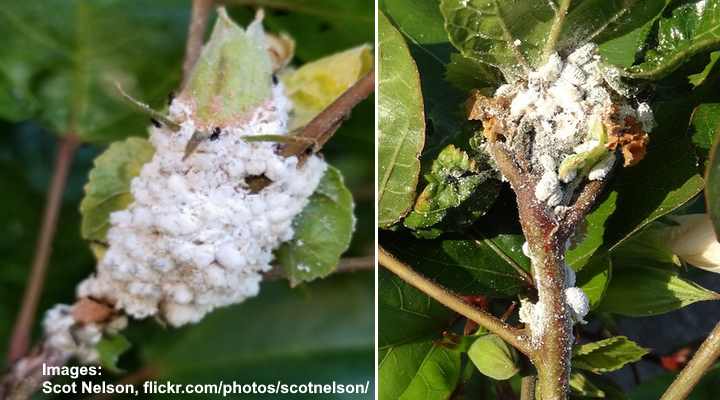
You can identify mealybug infestation on plants by their distinctive white furry clumps on the leaves or stems
The easiest way to identify mealybugs is by their fuzzy white appearance. Mealybug identification is usually done by the clumps of furry cotton wool-like fuzz on your plant—either colonies of bugs or collections of egg sacs. Individual mealybugs are tiny oval-shaped and hard to spot.
Unfortunately, by the time you identify mealybugs by the white furry cotton, the infestation is already extensive. Look for tiny white bugs that crawl around dark places on your plant. For example, mealybugs are common in succulents where they hide in the tight crevices between fleshy rosette leaves.
You can also identify mealybugs by the damage they do to plant foliage. Apart from leaving behind their telltale cottony residue, they affect plant growth in other ways. For example, a sticky honeydew secretion encourages black sooty mold growth. Black patches on plants with stunted growth can help identify the presence of mealybugs.
Identifying mealybugs correctly is key to eradicating them. Some other types of houseplant pests cause similar plant damage as mealybugs cause. For example, whiteflies also leave behind honeydew and cause black soot mold problems. So, to confirm the presence of mealybugs, identify the minuscule bugs by their oval white bodies with tiny spines.
Mealybug Damage to Plants
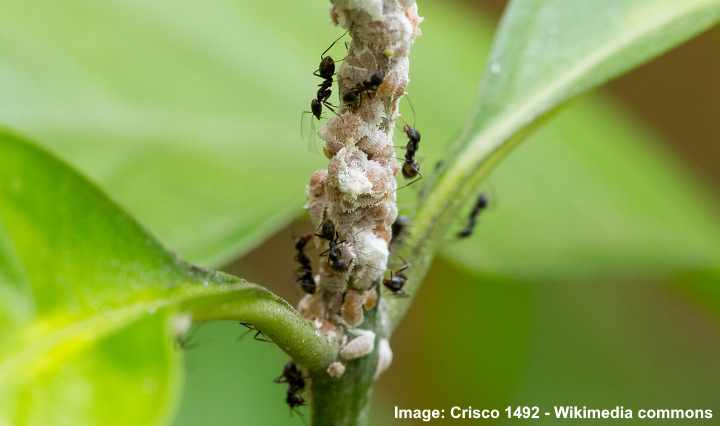
Mealybug infestation can damage plant growth when they feed on the plant’s sap
Mealybugs can cause extensive damage to houseplants. Stunted growth, yellowing leaves, leaf drop, are all ways that these tiny fuzzy white bugs damage plants. If you don’t get rid of mealybugs fast, the plant damage can be so extensive that they cause the houseplant to die.
The primary damage that mealybugs cause is by feeding on the plant’s sap. In time, a heavy bug infestation will literally suck the life out of plants. Fortunately, if you act quickly to eliminate mealybugs, you can save your plant and limit the damage.
Here are other signs of plant damage when it is infested by mealybugs:
- Waxy cotton deposits on plant—Most pictures of mealybug infestations show clumps of white fur on stems and leaves. You could also notice fuzzy white growth in the joins of leaves or stems.
- Honeydew—This sweet, sticky substance is bug excretion from feeding on plant juices. Although honeydew doesn’t harm plants, it shows that mealybugs are causing plant damage. The sweet substance can also attract ants.
- Black soot mold—Honeydew encourages black sooty mold. Although this black mold doesn’t damage the plant, it’s another sign that mealybugs are in the process of destroying your houseplants.
- Weak plant growth—The worst damage that mealybugs cause is to stunt plant growth. Usually, signs of a cottony residue on plants accompany wilted growth, drooping leaves, and discolored, unsightly foliage.
How to Get Rid of Mealybugs on Plants

The first step in getting rid of mealybugs on plants is to isolate the affected plant to prevent it from infesting other plants
The first step in getting rid of mealybugs on plants is to isolate the plant to prevent spreading to other plants. The second step should be eradication of the little white bugs by spraying or washing them with natural mealybug killer products.
It’s crucial to kill mealybugs as soon as you notice their presence. Although a few mealybugs won’t stress a plant too much, it’s only a matter of time before you’ve got a full-blown infestation.
It is best to avoid using chemical pesticides to kill mealybugs. Apart from being toxic to humans and pets, the pesky bugs can build resistance to chemicals. This makes eradicating the plant pests so much more difficult.
What are the best natural mealybug treatment methods to get rid of them for good?
The first step to getting rid of mealybugs is to isolate infected plants from other houseplants. Isolating plants prevents the bugs from spreading to other plants. Thoroughly inspect all parts of the plant—around leaf joints, under leaves, and in the top layer of soil around the stem. Then check around the rim of the pot and its base.
Wash Plants to Dislodge Mealybugs
Take infested plants to the bathroom and rinse off mealybugs under the shower. The force of water should be enough to dislodge the majority of the tiny white plant bugs. Water will also help wash away any unsightly cottony residue from foliage.
If you have a mealybug infestation on outdoor plants, you can turn the garden hose on the plants. A forceful jet of water can help to remove as many mealybugs from your plant as possible.
Use Rubbing Alcohol to Kill Mealybugs on Contact
Isopropyl alcohol kills many houseplant pests, including mealybugs on contact. To get rid of mealybugs on plants dip a cotton swab in 70% rubbing alcohol and apply directly to the tiny fuzzy pests.
You can also make a mealybug killer spray by diluting 1 cup of alcohol with 1 quart (1 l) of water in a spray bottle and apply to the affected plant. If the spray doesn’t damage your plant, you can repeat the spray treatment once a week until all the mealybugs are gone. The alcohol helps to dissolve the protective layer of the mealybugs and their eggs and kill them.
Because mealybugs can reside in soil, it may be a good idea to repot your plant in fresh, sterile soil. You can also use alcohol to disinfect the inside of the pot before adding a new potting mix. This helps to ensure that you get rid of all traces of these pesky bugs for good.
Use Liquid Soap Spray to Get Rid of Mealybugs on Plants
Soap spray can effectively kill mealybugs. Fill a spray bottle with 1 quart (1 l) of lukewarm water and add a teaspoon of liquid soap such as Castile soap or other liquid dish soap. Shake well and spray the bug killer all over the plant.
After an hour or two wash the plant with a damp cloth to reduce the chance of the soap damaging the plant. Spray the plant as often as necessary until your plant is pest-free.
The reason why soap spray work effectively is that it coats mealybugs with soapy liquid that helps to break down the wax.
Using organic soaps to get rid of bugs doesn’t pose any health threat to kids and pets.
Neem oil Spray to Get Rid of Mealybugs on Houseplants
Make a neem oil spray to get rid of mealybugs on houseplants by mixing two teaspoons of organic neem oil and one teaspoon Castile soap with 1 quart (1 l) of lukewarm water. Fill a spray bottle with the anti-mealybug solution, shake well and spray your plant liberally to kill the white bugs.
Spraying a neem oil solution is an excellent natural pesticide to kill mealybugs and other indoor plant pests. Neem oil is also excellent for preventing mealybugs.
When using neem oil as a homemade pesticide spray, it’s vital to remember that it takes time to work. Spray your succulents, cacti, or tropical houseplants regularly with neem oil for it to be effective. With some patience, you can soon get these pesky fuzzy bugs under control.
There is also scientific evidence for the effectiveness of using neem oil solutions to eradicate mealybugs. Researchers found that neem oil can kill mealybugs on contact. Also, the residual effect of neem oil helps control mealybug populations. Neem oil is especially useful on mealybugs in their nymph stage. (1)
Related: Common Houseplant Pests: Types, Identification, and Control
How to Prevent Mealybugs on Houseplants
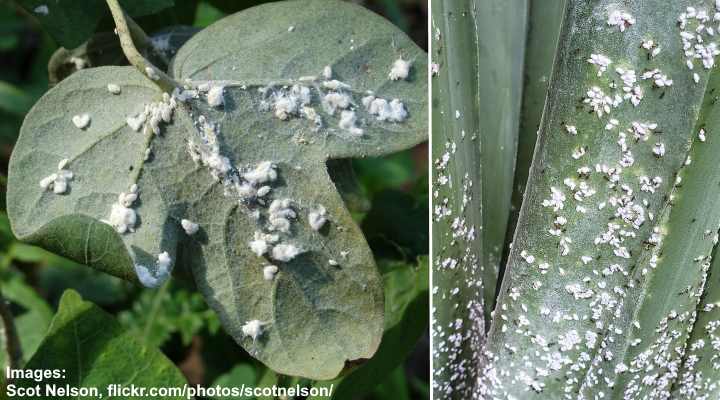
Make sure to inspect and isolate new plants before bringing them indoors to prevent mealybugs infestation of other plants
To prevent mealybug infections, inspect any new plant you bring into your home. You can also prevent mealybugs by creating a healthy environment for plants to grow well. Additionally, regularly wiping leaves with a damp cloth can help remove the small white bug before you notice them.
Avoid over-fertilization to control mealybugs
To prevent the fuzzy white bugs from reproducing, don’t add too much fertilizer to plants. Feeding plants should give them just enough nutrients to grow healthy. However, mealybugs thrive in nitrogen-rich soil, and too much of it creates the perfect environment for little white plant bugs to multiply.
Thoroughly check new houseplants for signs of mealybugs
As a general rule, you should always check new houseplants for signs of pests. Mealybugs can hide in between succulent leaves, in the joints of houseplants, and even in the soil. Look for tiny white creatures that look like grains of rice.
Even plants bought in reputable stores can have unwanted pests lurking in their foliage or potting mix. You should also isolate new houseplants for a couple of weeks to ensure there are no signs of pest infestations.
Change the potting soil to prevent further mealybug infestations
If you get recurring mealybug problems, you may need to change the potting mix. A fresh, sterile potting soil helps ensure that there is no trace of mealybugs. It’s best to completely change the soil, rather than just the top one or two inches.
To repot an infested plant, carefully remove the root ball and shake the soil into a garbage bag. Rinse the roots with water to ensure that no root mealybugs are lurking there. Thoroughly wash the container with warm soapy water. Repot your plant with an appropriate fresh potting mix. Discard contaminated soil in the trash can, rather than putting it into compost.
It’s best not to use soil from your garden. Mealybugs and other pests can come into homes in contaminated soil. And, yard soil can contain several types of parasites that are detrimental to houseplants.
Discover how to get rid of bugs in houseplants (including identification and pictures).
Related articles:
- How to Get Rid of Gnats on Houseplants
- How to Get Rid Of Aphids on Houseplants
- How to Kill Spider Mites On Plants
